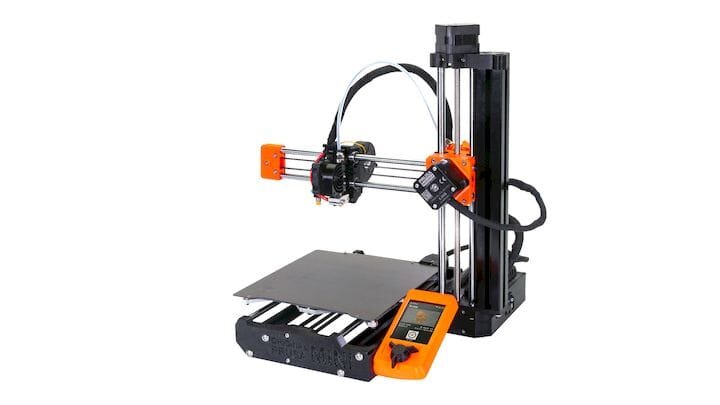![The new Original Prusa MINI 3D printer [Source: Prusa Research]](https://fabbaloo.com/wp-content/uploads/2020/05/image-asset_img_5eb08edc8da4b.jpg) The new Original Prusa MINI 3D printer [Source: Prusa Research]
The new Original Prusa MINI 3D printer [Source: Prusa Research]
Prusa Research has unexpectedly announced a brand new 3D printer, the Original Prusa MINI.
The Prague-based company has been extremely busy over the past year, deploying their flagship MK3S device, as well as the company’s first SLA-based 3D printer, the SL1.
The Original Prusa MINI 3D Printer
Now they’ve announced a new machine, the Original Prusa MINI. As you might expect, this machine is somewhat smaller than the standard-sized MK3S. However, though it is smaller in dimensions, it seems to have many of the features of its older sibling — and some surprises, too.
First, the basics.
Original Prusa MINI Specifications
![Comparison of the maximum build volume of the Prusa MINI and Prusa MK3S [Source: Prusa Research]](https://fabbaloo.com/wp-content/uploads/2020/05/image-asset_img_5eb08edcd5471.jpg) Comparison of the maximum build volume of the Prusa MINI and Prusa MK3S [Source: Prusa Research]
Comparison of the maximum build volume of the Prusa MINI and Prusa MK3S [Source: Prusa Research]
The MINI does indeed have a smaller build volume, at only 180 x 180 x 180 mm. This is as compared to the MK3S’s 250 x 210 x 210 mm. In truth, it really isn’t that much smaller and the 180 mm dimension is likely large enough for almost all prints. Another way to look at this is to ask yourself how many times you have a print having dimensions between 180 and 210 mm? Not terribly often, I would guess.
One quite visible change from the MK3S is that the gantry is different. While the MK3S has a full U-shaped tower, the MINI does not. Instead it has a cantilevered configuration that uses far less material. It would appear that this style might have somewhat less stability, but it remains to be seen whether this is a significant factor.
Perhaps the most significant difference is that the MINI does not use a direct drive extruder. Instead it uses a Bowden extruder, where the motor is off to the side and pushes the filament through a tube to the hot end. This may result in challenges 3D printing flexible filament, although Prusa Research says flex is supported.
It goes without saying that the MINI is not capable of accepting an MMU2S (multi-material unit) upgrade, as the MK3S can. To be clear, there are some functional limitations of the MINI, but if they are an issue for you, choose the MK3S instead.
There are many identical features between the two machines, as the MINI has inherited quite a bit of technology. The same removable magnetic bed surface is used; the same hot end is used (although the MINI can hit only 280C, whereas the MK3S can hit 300C); automatic mesh bed leveling is incorporated; layer heights are the same. Because of this it’s likely the MINI is able to produce high-quality prints.
Original Prusa MINI Options
Some features are optional on the MINI. A filament-out sensor, standard on the MK3S, is a US$20 option on the MINI. Similarly, there is an optional WiFi connection upgrade, which is not even available on the MK3S.
One MK3S features that is not available on the MINI is recovery from power outages. Another is that the MINI is available only as a kit. However, the kit seems to be ridiculously simple to assemble as it contains only three components. Prusa Research says you can be up and running in less than 30 minutes.
That leads to the interesting part: there are some features on the MINI that are not available on the MK3S.
Original Prusa MINI Color Screen
One is a color screen! However, it’s not a touchscreen and is operated by a wheel. This is a definite improvement over the increasingly-ancient-appearing LCD screen found on the MK3S.
You can see the new screen and the other features in the official Prusa Research video:
Original Prusa MINI Farm Mode
There’s another very intriguing bit from Prusa Research: “Farm Mode”.
It’s not clear what this is, but Prusa Research says it’s “coming soon”. It is likely a mode in which arrays of MINIs can be operated in some type of production mode. Farm Mode is no doubt some variation of the system used by Prusa Research in their in-house production facility, so it likely is of good quality. I’ll have a lot more thoughts about this development in the near future.
Original Prusa MINI Price
Finally, the best part. The price.
While the MK3S kit sells for US$749, the MINI is priced at an amazing US$349! If the MINI proves to produce high-quality prints and be as reliable as the MK3S, it will be a huge seller at that price point.
The price point is quite competitive with many low-priced Asian machines, so Prusa Research seems to be addressing that challenge head-on.
I’m hoping to be able to test one of these units in the future.
Via Prusa Blog and Prusa Research

